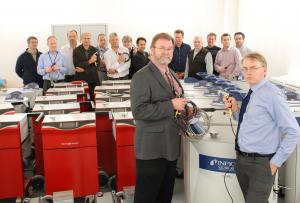Armed and ready to identify leaks
6 May 2013
A collaborative success: The ITER vacuum team poses in the basement storage room in Headquarters where the leak detection devices shipped in from the US are piling up.
In constructing ITER, one of the key challenges is to ensure a leak-free machine. The US Domestic Agency has recently completed the bulk of delivery for the test equipment required to confirm the vacuum leak-tightness of components as they arrive on site and during the construction of the machine. At right, vacuum team members are pictured with some of the leak detection tools-of-the-trade: helium spray guns and highly sensitive mass spectrometer-based detectors.
"This procurement is the very first US ITER procurement to be delivered to the ITER site," rejoices Mike Hechler, the responsible officer within the US vacuum team. "Hence it should be celebrated as a real success. Being first we were like guinea pigs having to sort out how to deal with transport, VAT charges, customs, CE marking. It was not easy, but opens up the way for future US deliveries."
"The basic method of leak detection is simple," explains Liam Worth, member of the ITER vacuum team and responsible for the test program. "You evacuate your vacuum vessel, surround it with helium gas, and then use the leak detector to look for helium leaking in—these instruments can detect in the minutest quantities." However the size, complexity and number of the ITER vacuum systems make this a far from simple task. "We estimate that from acceptance to the final commissioning of the machine, no fewer than 94 man-years of vacuum testing will have to be performed."


